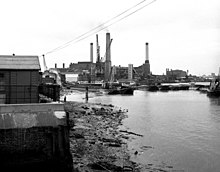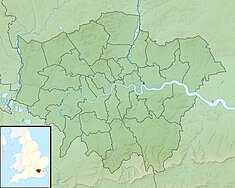Deptford Power Station
| Deptford Power Station | |
|---|---|

Deptford West Power Station
Viewed from the east in July 1973 |
|
| Country | England |
| Location | Greater London |
| Coordinates | 51°28′57″N 0°01′13″W / 51.4824°N 0.0203°WCoordinates: 51°28′57″N 0°01′13″W / 51.4824°N 0.0203°W |
| Commission date | 1891 (Depford East LP) 1929 (Deptford West) 1953 (Deptford East HP) |
| Decommission date | Late 1960s (Deptford East LP) Early 1970s (Deptford West) 1983 (Deptford East HP) |
| Operator(s) | London Electric Supply Corporation 1891-1925, London Power Company 1925-48, British Electricity Authority 1948-54, Central Electricity Authority 1954-57, CEGB 1957-83 |
| Thermal power station | |
| Primary fuel | Coal-fired |
| Power generation | |
| Nameplate capacity | 448 MW (70 MW approx Deptford East LP, 212 MW Deptford West, 166 MW Deptford East HP) |
| grid reference TQ374778 | |
Three distinct coal-fired power stations were built at Deptford on the south bank of the River Thames, the first of which is regarded as the first central high-voltage power station in the world.
(LP = Low Pressure). One of the first premises in London to be supplied with electricity was the Grosvenor Gallery in Bond Street. It was the brainchild of the Earl of Crawford, who had been inspired in 1881 by the International Exposition of Electricity in Paris. A power plant was duly built at the Grosvenor Gallery. It was designed to supply just lighting for the gallery but it was soon extended to supply nearby shops and residences and a larger power plant was opened in 1884. With the prospect of expanding still further, the London Electric Supply Corporation was formed (LESCo). Principal shareholders were the Earl of Crawford, his friend Sir Coutts Lindsay and Sir Coutts’ brother, Lord Wantage.
There were environmental objections to large-scale power generation in Central London, so LESCo decided to move to a new site in Deptford and to use the Grosvenor Gallery site as a substation. A feature of the Grosvenor scheme was its use of alternating current (AC) in preference to direct current (DC). The use of AC allowed the voltage to be raised to 10 kV for transmission between Deptford and Grosvenor Gallery. High-voltage cables were laid alongside the London & Greenwich Railway line, but cable design at that time was rudimentary, having short lengths and many joints. This caused a voltage drop of some 10% from end to end. In order to supply at 10 kV at Grosvenor Gallery substation, the design voltage at Deptford had to be set at 11 kV, which is why national transmission voltages became standardised in multiples of eleven.
Sebastian de Ferranti was appointed to engineer the scheme, and the world’s first central power station opened at Deptford in 1889. ‘Central’ means that it was remote from most of its consumers. To distinguish it from later adjacent developments, Ferranti’s power station subsequently took the name Deptford East LP. It was pioneering not just because it was ‘central’ but because of its unprecedented scale and high voltage. It was built on a 3-acre warehouse site called The Stowage which once belonged to the East India Company. There were initially two generators driven by reciprocating steam engines, supplied by 24 boilers burning coal brought by collier from Newcastle. There were teething problems both at the power station and at the Grosvenor Gallery substation, resulting in lengthy shutdowns and loss of customers. Ferranti himself was sacked in 1891 and was succeeded by G.W. Partridge as chief engineer. The plant was rebuilt with steam turbines and other improvements, and electricity supply eventually became reliable. Demand increased steadily with customers supplied through different systems as follows:
...
Wikipedia

